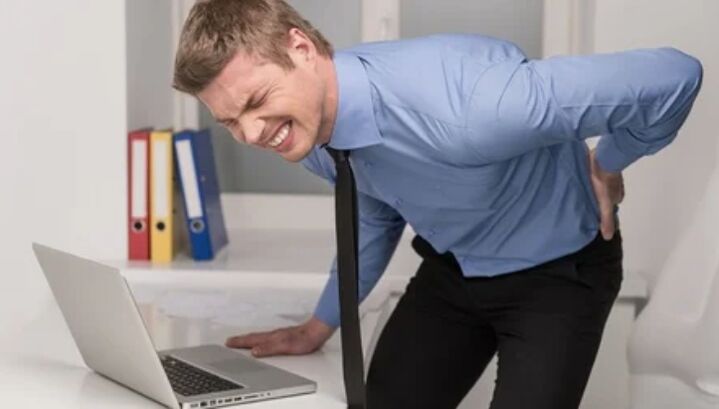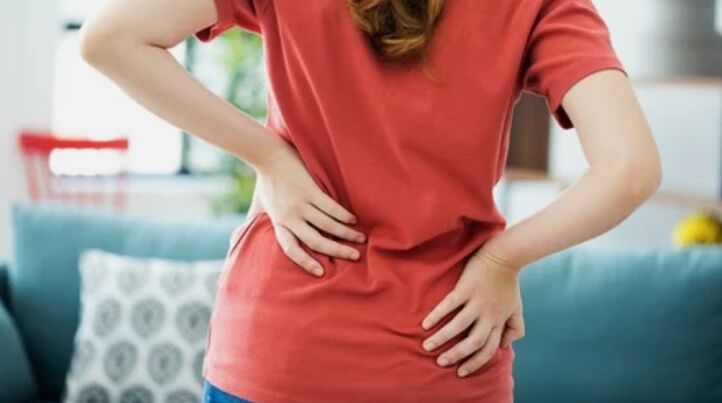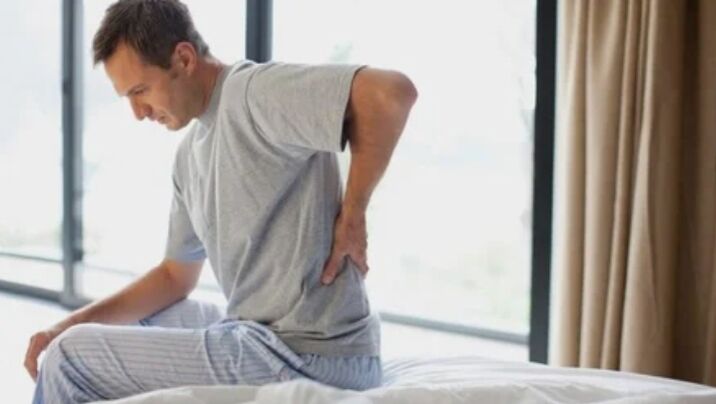With the advent of discomfort in the spine, almost everyone is facing.Using painkillers, most residents do not ask the question of why the back is painful, associating negative manifestations of cold, draft or consequence of stretching.Meanwhile, painful syndrome (BS) can be a worrying signal for the emergence of serious pathology.

In different parts
Back pain is different.
Among them are distinguished:
- Fight.Different in frequency.
- Grow.In the process of pathological conditions, increased levels of uncomfortable manifestation occur.
- Knife.Is the result of an emergency.
- In the form of a fire.They are recorded in the case of impaired function of the spinal column.
- Permanent or boring.
In addition, back pain can be two types:
- Projected.It spreads along the nerve fibers.It can radiate to the distal part of the body.
- Reflected.Appears during damage in the work of the internal organs.
On the right
There are several conditions that explain why the back of the pain is on the right.They are:
- The result of hypodynamia, in which the abdominal muscles lose its elasticity and elasticity, while the entire load is placed on the spinal column;
- injury and soft tissue bruises;
- Perform physical work in improper position (with uneven load).
In addition to natural factors, the cause of uncomfortable sensation can be an internal organ disease and musculoskeletal system.
These symptoms can be part of the clinical picture for the following diseases:
- Respiratory system disease.With inflammation of the lungs (inflammation of the right lung), in addition to back pain, the patient complains about the appearance of dry cough, general weakness, increased body temperature indicator.
- BS stabbing on the right is observed with pleurisy.It is accompanied by purulent discharge and breathing difficulty.
- Liver pathology and gall bladder.BS is distinguished by the current period.To stop it, painkillers or antispasmodic drugs are used.The clinical picture is equipped with signs of intoxication (nausea, vomiting, violation of the disinfection).
- Gastrointestinal disease.With pancreatitis or gastritis, the pain syndrome is usually localized on the left, but often radiates to the right.
- UrinaryThey are indicated by prolonged or stupid pain.It occurs in frequent urinary tract backgrounds, with the advent of red blood cells (blood) in urine.A distinctive feature is that the sick person cannot find a simple body position to reduce back pain.
- Appendicitis.In addition to unpleasant sensations in the stomach, the patient notes that the back pain is on the right.Additional symptoms are the appearance of nausea and vomiting, increase in body temperature indicators, general damage.
- Gynecological pathology.The manifestation of discomfort on the right is recorded in the event of ectopic pregnancy, complementary inflammation or due to the growth of the ovarian seal.
- Osteochondrosis.The pain can be localized to the right and left.It is accompanied by stiffness in movement, and increases with physical work (especially if someone does it for the first time).In advanced form, the irradiation of the finger with their numbness is observed.
On the left
The localization of back pain can be a major or additional symptom in the clinical picture of many diseases.

It can happen in the following cases:
- Spinal column disease.Often, the patient complains that the back pain is caused by osteochondrosis, intercostal neuralgia or when pinching the nerve.The clinical picture comes with stiffness in movement, radiation at the top, loss of sensitivity to the finger.
- Stomach and intestinal diseases.Symptoms of pain manifestation are supplemented by the presence of nausea, vomiting, impurities and increased gas formation.These signs arise with the development of pancreatitis, intestinal colitis, cholecystitis.
- Cardiological disease.Acute pain syndrome from the back below the ribs in combination with shortness of breath and burning sensation behind the sternum is a sign of myocardial infarction.
- In bronchi and lungs BS can be observed with the development of pneumothorax, pleurisy, bronchitis or inflammation of the lung.It can be intensified when inhalation, and a decrease in breathing.
In the lower back area
The lumbar region begins from the place where the ribs end, and end with a coccyge.Often, the patient, seeking medical help with a back pain complaint, implies the bottom.
The cause of lumbar pain is the following condition:
- 90% of all cases of lumbar pain are explained by a violation of spinal column function (osteochondrosis, hernia between vertebrae, scoliosis, radiculite).This condition is characterized by symptoms in the form of a sudden shot.
- In 6%, pain in the lower part is the result of infringement of the urinary tract.This feature is shown for pyelonephritis, cystitis, glomerulonephritis or in the formation of calculi (stone) in the kidneys.
- 4% are other internal organ diseases (stomach, intestines).
In the blade area
One can feel pain in the shoulder blade area in different localization:
- The pain syndrome is localized under the shoulder blade.The nature of this BS is recorded by the presence of ulcers and erosion in the stomach.At the same time, the main center of negative sensation is concentrated in the epigastric zone, and the irradiation gives it to the shoulder blade.
- Chest compression, pain and stupid pain often cause osteochondrosis or myositis.
- When the back hurts between the shoulder blades, with a high probability, it can be assumed about the localization of intercostal neuralgia (if BS occurs in the form of a fireplace).In the case of the development of inflammation of the lungs, the painful sensation is enhanced by coughing and at the top of the complaint.
- BS in the shoulder blade most often shows itself as a -traumatic post.Symptoms of negative sensation are enhanced when the limbs move.

Along the spine
The cause of back pain along the spine may be the following condition:
- Lumbalgia.It shows itself acute after lifting the weight.
- Stoop, scoliosis or kyphosis cause the uncomfortable sensation that is indicated by attractive or BS pain.
- The highlight of the hernial between the vertebra leads to the compression of the nerve root, so the burning sensation appears along the spinal column.In this case, there is a loss of sensitivity in the back.
- Cervical and thoracic osteochondrosis leads to changes in the spinous vertebra process, which is a result of persistent injury to their nerve ending.This causes back pain and stiffness in movement.
- Injuries trigger acute and sharp pain syndrome.In the event of damage to the spinal cord, lower leg sensitivity occurs.
- Arthritis is characterized by a gradual increase in discomfort, with the emergence of crisis and clicking on the vertebra.
- Endometriosis and adnexitis cause discomfort in the spine due to the anatomy of the female reproductive organs (in the lower abdomen).
Under the lower back
The lumbosacral department is most often burdened by lifting improper severity, walking or from staying in a sitting position.But this situation just partially explains why the back pain is under the lower back.
Discomfort occurred at:
- pathological changes in the spine (arthrosis, osteochondrosis, hernia stands between vertebrae);
- after injury to the sacrum or coccyx;
- In the event of a posture (scoliosis or lordosis).
Pain in the sacred department occurs in genitourinary spheres, constipation, cholecystitis or gastritis.In women, these symptoms may indicate pregnancy or menopause.Sometimes it shows the beginning of the menstrual cycle.
Pain in the back after sleep
Sometimes someone records strong fatigue and fractions after the night's rest.

Often, the following factors contribute to this:
- incorrect organization from the bed (the mattress is too hard or soft);
- increased physical activity or a large amount of work during the day;
- Damage changes with impaired function of the vertebra and disc between them;
- Age -related changes in the cartilage of the intervertebral disc;
- as a result of injury;
- Inflammation in the internal organs of the abdominal cavity.
Pain in the muscles
The pathological processes in the vertebral and intervertebral discs change the structure of the bone and cartilage.Therefore, there are muscle overvoltage and tendon fascia.This leads to the fact that the body reacts to the incidence of BS.
In some cases, it is noted that back pain after a long stay in the draft or during hypothermia.Both factors contribute to the manifestation of myositis, in which pain is localized to the surface muscle.A distinctive feature is an increase in discomfort in the palpation or when the patient attempts to turn or tilt with the body.Sometimes his symptoms appear after the blade and bruises.
Painful syndrome in muscle groups often occurs due to intense training among athletes.In this case, the muscle fibers that are too much elasticity, the seals appear in it, which is detected on palpation.
Cause
Back pain is diagnosed with various diseases.
These include:
- Pathological processes in the spine (hernia, spondylitis, arthralgia, radiculitis);
- myocardial infarction, aortic aneurysm;
- stomach and intestinal diseases (pancreatitis, colitis);
- Calculi formation in the kidneys, cholecystitis, colic liver.
At the same time, all diseases have different etiology, which are taken into account when choosing treatment tactics.
Degenerative pathology
Degenerative changes occur in cartilage and bone tissue.Violation of the morphological structure causes dysfunction, thus osteochondrosis, spondylosis or spondil arthrosis.
Among the factors that cause destructive changes, they distinguish:
- violations of metabolism that cause inadequate nutrient intake to the intervertebral disc;
- Limited intake of elements -beneficial traces in the body;
- Large burden and injury;
- damage to the endocrine system;
- Bad habits, for example, smoking and excessive addiction to alcoholic beverages;
- Hypodynamia and inactive lifestyle.
Integration
Diseases that lead to inflammation in the spine can occur independently and are the result of pathological complications.They are recorded in rare cases, but pose a serious threat to the patient's health.

The focus of the inflammation can be located in the different sections of the vertebra:
- In the front, spondylitis, dycitis or spondylodisites are most often diagnosed;
- Back localization causes the development of osteomyelitis, spondylitis or paravertebral abscess;
- If the spinal cord is infected, then inflammation is indicated by the development of abscess or epidurite.
In addition, spinal tissue can be affected due to tuberculosis, brucellosis, trichinellosis (various helminthiasis).
This type of pathology is characterized by a sharp pain in the muscle group, which is difficult to eliminate analgesics.Clinical pictures can be supplemented by related symptoms, for example, with increased spasmodic in body temperature and loss of sensitivity to certain areas of the spinal column.
Miofascial Syndrome
Myofascial syndrome has a chronic course with the formation of seals in muscle tissue in the form of pain (triggers).This causes not only severe discomfort, but also leads to a decrease in motor activity, as a result, patients quickly become tired even from small physical activity.
The probability of developing myofascial syndrome has increased many times in the following situations:
- osteochondrosis, spondylarthrosis, injury and bruises;
- In the case of diagnosis of scoliosis or with flat feet;
- If the work is related to the repetition of stereotype movements;
- If it violates the psychoemotional state (if this is the case with increased muscle pressure).
An important importance in clinical practice is given to the state of the trigger.They are active or hidden.
In view of this, they are classified as follows:
- Acute form.The trigger point is active and causes discomfort when trying to make movements.
- Subakut.Negative manifestations disappear at rest.
- Chronic.The latent state only causes insignificant discomfort in the corresponding area.
In addition, to carry out the right therapeutic options, classifications are used in neurology according to the etiological principles:
- The main trigger point is formed by muscle damage;
- Secondary is recorded as violating the function of the joints and somatic organs.
The cause of physiological
Different groups of physiological causes pain in the muscle corset are called domestic.They do not need treatment and pass on their own, after a small rest.
These include:
- doing difficult physical work for a long time;
- Weakness or fatigue;
- Pose selected incorrectly for night rest or performing boring actions while working;
- Bad organizations of the night bed;
- A less selected mattress or pillow.
To establish the cause of back pain, you must consult a doctor, as this may require some diagnostic steps.This will determine the tactics of the treatment process, which will not allow the transition to the disease to be neglected.






















